Assessment of Land Subsidence Pattern in Pokhara Valley Using Sentinel-1 InSAR Processing
DOI:
https://doi.org/10.3126/joetp.v5i1.69649Keywords:
Land subsidence, Sentinel-1, InSAR, Infrastructure Management, Sustainable DevelopmentAbstract
This research examines the use of Sentinel-1's enhanced remote method and Interferometric Synthetic Aperture Radar (InSAR) processing to monitor ground subsidence in Pokhara Valley City, Nepal. It aims to comprehend the reciprocal effects of land sinking on environmental sustainability, infrastructure stability, and urban growth. The methodology encompasses the acquisition and processing of Sentinel-1 SAR data, along with rigorous interferometric analysis to detect and quantify ground deformation. Spanning from 2019 to 2022 AD and, -analyzing annual displacement trends, initially, a subsiding trend was observed in 2019-20 AD with an average rate of 0.037 m/year followed by 0.072 m/year in 2020-21 AD, and then escalating to 0.165 m/year in 2021-22 AD. These fluctuations in rates illustrate the intricate interplay of urbanization and geological dynamics affecting land stability in the region. The implications of this study extend to urban planning and infrastructure management, emphasizing the necessity of integrating land subsidence monitoring into the developmental policies and strategies of Pokhara Valley. Additionally, the potential of Sentinel-1 InSAR as a valuable tool for geotechnical investigations offers a non-invasive, cost-effective means to assess and monitor ground deformation risks. By leveraging the capabilities of Sentinel-1 InSAR, the study contributes to the body of knowledge in geotechnical and civil engineering fields, particularly within the context of sustainable urban planning and disaster risk reduction.
Downloads
Downloads
Published
How to Cite
Issue
Section
License
Copyright © Faculty of Engineering, Far Western University

